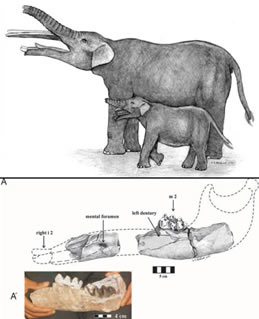Elephant "Missing Link" Fossil Found,
Elephant "Missing Link" Fossil Found,
Study Says Nicholas Bakalar for National Geographic News October 31, 2006
Parts of a fossil jawbone discovered by a farmer in Eritrea (http://www.nationalgeographic.com/places/countries/country_eritrea.html) might belong to a "missing link" species that connects modern elephants to their ancient ancestors.
The lower jaw fragments were found in the Dogali fossil site in the eastern part of the African country (Eritrea map (http://www.nationalgeographic.com/xpeditions/atlas/index.html?Parent=africa&Rootmap=eritre&Mode=d&SubMode=w)). They date back to about 27 million years ago.
The bones belong to an animal in the order Proboscidea—large mammals with trunks—the same order that includes living elephants (http://www.nationalgeographic.com/animals/mammals/african-elephant.html).
In a paper that appears in the online early edition of Proceedings of the National Academy of Sciences, the researchers name the new species Eritreum melakeghebrekristosi.
The name is derived from the site of the find and Melake Ghebrekristos, the local farmer who brought the specimen to scientists' attention.
"Throughout Africa, there is a gap in the proboscidean record in the late Oligocene, 34 to 24 million years ago," said Jeheskel Shoshani, the lead author of the study and professor of biology at the University of Asmara in Eritrea.
"Whenever there is a gap in the record, it's significant when you find specimens from that period. These specimens date from exactly the time where there is a gap."
Tooth Conveyer Belt
The jawbone pieces were discovered with teeth in place, allowing researchers to hypothesize that the animal replaced its teeth through a process called horizontal tooth displacement—the same "conveyor belt" style seen in living elephants.
If this theory is correct, E. melakeghebrekristosi would be the earliest known proboscidean to exhibit this characteristic.
The size of the teeth is another indication of the intermediate evolutionary stage of the species.



